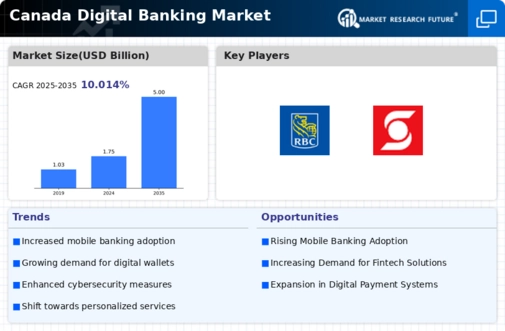Rising Consumer Demand for Convenience
The digital banking market in Canada is experiencing a notable shift as consumers increasingly prioritize convenience in their banking experiences. This demand is reflected in the growing adoption of mobile banking applications, which allow users to perform transactions anytime and anywhere. According to recent data, approximately 75% of Canadians utilize mobile banking services, indicating a strong preference for digital solutions. This trend is likely to drive further innovation within the digital banking market, as financial institutions strive to enhance user experience and streamline services. The emphasis on convenience is not merely a passing trend; it appears to be a fundamental shift in consumer behavior, compelling banks to adapt their offerings to meet these evolving expectations.
Growing Emphasis on Financial Inclusion
The digital banking market in Canada is witnessing a growing emphasis on financial inclusion, as institutions strive to provide services to underserved populations. This focus is particularly relevant in rural areas, where access to traditional banking services may be limited. By leveraging digital platforms, banks can reach a broader audience, offering essential financial services to those who previously lacked access. Initiatives aimed at promoting financial literacy and accessibility are likely to enhance participation in the digital banking market, fostering a more inclusive financial ecosystem. This trend not only benefits consumers but also presents opportunities for banks to expand their customer base and drive growth.
Increased Investment in Fintech Solutions
Investment in fintech solutions is a driving force behind the evolution of the digital banking market in Canada. Financial institutions are increasingly collaborating with fintech companies to enhance their service offerings and improve operational efficiency. In 2025, it is estimated that investments in fintech in Canada could reach upwards of $3 billion, reflecting a robust interest in innovative financial technologies. This influx of capital is likely to accelerate the development of new digital banking products, such as AI-driven financial advisory services and blockchain-based payment systems. As these technologies mature, they may reshape the competitive landscape of the digital banking market, providing consumers with more choices and better services.
Shift Towards Sustainable Banking Practices
Sustainability is becoming an increasingly important consideration within the digital banking market in Canada. Financial institutions are recognizing the need to align their operations with environmentally friendly practices, responding to consumer demand for responsible banking. This shift is evident in the rise of green banking initiatives, which focus on offering products that support sustainable development. For instance, banks are introducing eco-friendly loans and investment options that prioritize environmental impact. As consumers become more environmentally conscious, the digital banking market may see a growing trend towards sustainability, compelling banks to innovate and adapt their offerings to meet these new expectations.
Regulatory Support for Digital Transformation
The Canadian government has been actively promoting digital transformation within the financial sector, which significantly impacts the digital banking market. Regulatory bodies are implementing frameworks that encourage innovation while ensuring consumer protection. For instance, the Financial Transactions and Reports Analysis Centre of Canada (FINTRAC) has established guidelines that facilitate the integration of new technologies in banking. This supportive regulatory environment is likely to foster competition among financial institutions, leading to enhanced services and products for consumers. As regulations evolve, they may further stimulate growth in the digital banking market, enabling banks to leverage technology to improve efficiency and customer engagement.













Leave a Comment